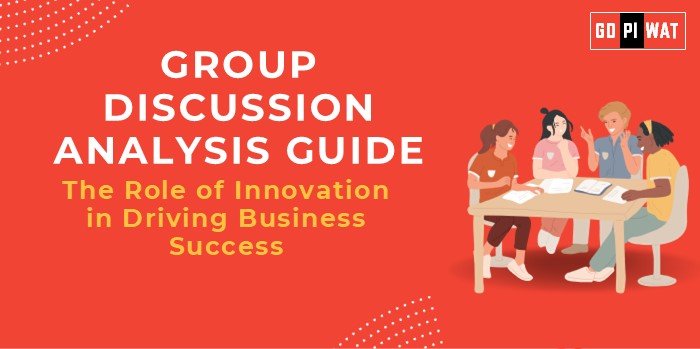📋 Group Discussion (GD) Analysis Guide
🌟 Topic: The Role of Innovation in Driving Business Success
🌐 Introduction to The Role of Innovation in Driving Business Success
Opening Context: “Innovation has become the backbone of modern businesses, driving competitive advantage, fostering customer satisfaction, and ensuring long-term sustainability in an ever-evolving global market.”
Topic Background: Innovation involves introducing new processes, ideas, or products that improve efficiency, productivity, and market relevance. Businesses like Apple, Tesla, and Amazon exemplify how innovation transforms industries and redefines customer experiences. With increasing competition and technological advancements, innovation is no longer optional but critical for success.
📊 Quick Facts and Key Statistics
- Global R&D Expenditure: $2.5 trillion annually (UNESCO, 2023), showcasing growing focus on innovation.
- Top Innovators: Companies like Amazon, Alphabet, and Microsoft lead global innovation rankings (BCG 2023).
- Start-Up Growth: India ranks third globally, with over 90,000 startups fueled by innovation.
- Economic Impact: Innovative companies outperform competitors by 30% in profitability (McKinsey).
- SME Contribution: 60% of SMEs cite innovation as essential for scaling operations (World Bank).
👥 Stakeholders and Their Roles
- Businesses and Corporates: Drive innovation through R&D investments, employee-driven ideation, and strategic partnerships.
- Government: Formulate policies, provide financial support, and create innovation hubs.
- Customers: Demand better products, pushing companies to innovate for customer satisfaction.
- Academia and Research Institutes: Act as centers of invention, collaborating with industries.
- Investors and VCs: Fund disruptive startups and innovative ventures.
✨ Achievements and Challenges
Achievements
- Tech Giants: Companies like Amazon and Apple thrive on innovation (e.g., Alexa, iPhone).
- Cost Efficiency: Process innovations have led to reduced operational costs (e.g., Toyota’s Lean Manufacturing).
- Start-Up Ecosystems: Countries like India and Israel have seen booming startups through tech innovation.
- Global Sustainability: Innovations in renewable energy reduce dependence on fossil fuels.
Challenges
- High Costs: R&D and innovation investments require substantial funding, limiting small businesses.
- Failure Risks: 90% of new innovations fail (Harvard Business Review, 2023).
- Regulatory Hurdles: Policies and IP issues often limit innovative progress.
🌍 Global Comparisons
- USA: Strong culture of innovation with tech clusters like Silicon Valley.
- China: Focuses on high-tech advancements, smart cities, and AI.
- India: Fast-growing startup culture but needs greater funding and infrastructure support.
Case Studies
- Tesla: Revolutionized the automobile industry through electric vehicles.
- Zomato: Leveraged innovation in food delivery using AI and drone testing.
📜 Structured Arguments for Discussion
- Supporting Stance: “Innovation creates unparalleled competitive advantage, enabling businesses to disrupt markets and boost profitability.”
- Opposing Stance: “Innovation comes with risks; businesses can overinvest without measurable returns.”
- Balanced Perspective: “While innovation fuels growth, a sustainable framework balancing risks and rewards is essential.”
🔍 Effective Discussion Approaches
Opening Approaches
- Start with a Quote: “As Steve Jobs said, ‘Innovation distinguishes between a leader and a follower.’ This defines business success in today’s world.”
- Use Data: “Global businesses investing in innovation saw 30% higher revenues than non-innovators last year.”
Counter-Argument Handling
- Example rebuttal: “While innovation is risky, companies like Amazon and Google show that calculated risks yield exponential growth.”
📝 Strategic Analysis of Strengths and Weaknesses
- Strengths: Competitive advantage, increased customer satisfaction, market disruption.
- Weaknesses: High failure rate, financial risks, and need for constant investment.
- Opportunities: Technological advancements (AI, IoT), global collaboration, emerging markets.
- Threats: Technological obsolescence, economic downturns, and regulatory barriers.
📚 Connecting with B-School Applications
Real-World Applications
- Project themes on innovation in supply chains, sustainability, or digital transformation.
- Case analysis on companies like Tesla, Airbnb, and Zoom.
Sample Interview Questions
- “How does innovation drive long-term success in industries like automobile or retail?”
- “Discuss a failed innovation and key learnings from it.”
Insights for B-School Students
- Focus on case studies demonstrating innovation’s role in scaling businesses.
- Analyze how disruptive innovation creates new markets and opportunities.


